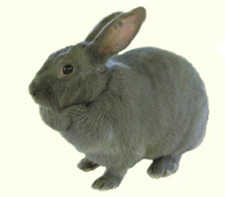 | Home | Bucks | Does | Litters | About Rabbits | For Sale | Links | Friends |
| Home | Bucks | Does | Litters | About Rabbits | For Sale | Links | Friends |


Lilac Rabbit History
(From the National Lilac Rabbit Club of America website)
The Lilac rabbit was developed in two different countries at about the same time. In 1917,
Mr. C.H. Spruty of the Netherlands is credited with having bred the first Lilac-like breed
of rabbit. The breed was called the Gouda and spread into France and Germany, where they
are raised under the same name today. The Gouda is recognized as a fur and meat rabbit and
weighs between seven and eight pounds.
In England, the famous geneticist, R.C. Punnet, bred the first Lilacs in 1922. He crossed
blue Beverens (dilute black) with Havanas (recessive chocolate). By combining these
characters, the Cambridge Blue (dilute chocolate) was created. The British Rabbit Club
recognized this rabbit as a new breed and called them Lilacs.
In America, the Lilac had its beginnings in both English and Continental European imports.
Between 1922 and 1926, many shipments were sent to the U.S. and there was a great deal of
interest in the new breed. The cover of the September, 1925, Rabbitcraft (which became Small
Stock Magazine), featured an English Lilac which had been exported to Canada. The 1928
American Standard of Perfection states, "that Lilacs were quite popular on the West Coast
and were spreading into the rest of the country." The English standard was adopted by the
American fanciers. Through 1939-1944, no changes were made to the standard and a National
Lilac Club was formed. In 1940, 25 Lilacs were shown at the ARBA National Convention. The
breed had several admirers and was gaining in popularity.
By 1951, the Lilac Club had become inactive and the Lilac had lost most of its breeders;
only 6 were shown at the National. In 1952, a few breeders reorganized the Lilac Club. Ken
Fehrman, "Mr. Lilac", became secretary of the club and remained in office until his death
in 1987. Orville Bloomquist became president and remained in office until his death in
1993. The 1973 National Convention in Detroit, Michigan, had 31 Lilacs entered, which made
it the largest shown by 8 exhibitors. The 1996 ARBA National Convention was also a banner
year with 36 Lilacs shown by 10 exhibitors.
There is also a Belgian breed of Lilac called the Gris Perle de Hal, said to be a sport
from the Havana.
General Description of the Lilac Rabbit
The Lilac is a meat breed, judged as a four class rabbit. They should be posed as a
commerial rabbit, like a Californian or a New Zealand. Bucks ideally should weigh
between 6 and 7 pounds. Does ideally should weigh between 6 1/2 to 7 1/2 pounds. The
coat should be a dove-gray color with a pinkish tint on the surface, uniform over
the entire body. Eyes to match fur and to glow ruby red in subdued light. Fur is
roll-back. Most of the points when being judged are on the fur and the color of the
fur. Second only to general type. Disqualifications include: white toenails,
mismatched toenails on the same foot or corresponding feet, white spot or spots in
the fur.


~ KSS Rabbitry ~
Katelynn S. Sokolowski
Haskell, Oklahoma
Phone: 915-482-1560
Email: katers20011@yahoo.com
| Home | Bucks | Does | Litters | About Rabbits | For Sale | Links | Friends |
|